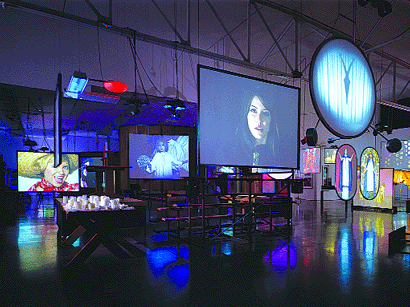Reconstructing familiar dreams as dread nightmares
Mike Kelley, who lives and works in Los Angeles, came of age during a time when America was flexing its muscles as a new world power, in the process of creating an imagined post-war utopia. Promise and plenty were the American dream as suburban families multiplied, and the task of training the newest Americans was transferred to the institutional system of schools.
Kelley has spent many years collecting photographs taken of “extracurricular activities” where many ideologies and values were acted out in plays, musicals, religious, and holiday pageants. In these shows, belief systems could be disguised with fantasy and fun, while moral and cultural faith could subliminally be passed on and conceptions of right and wrong forever implanted in young minds.
This exhibition is reminiscent of “Hell House” enactments of abortion as the consequence of sex, and car crashes as a result of drugging and drinking devised in the mid-90s by Assembly of God minister Keenan Roberts—using horror to correct the morals of kids who enter the hauntedhouse. In the last room, the church tried to “save” the souls of these kids and get them to turn their life over to Jesus, keeping them from the flames of hell. After scaring them to death, they could reprogram the preferred moral code.
The exhibition is formally stunning. The gallery is filled with floating video screens, props, costumes, and soundtracks. Each installation is programmed to turn on and off, prompting the viewer to move from ritual to ritual. Several acts run simultaneously, creating a fun house or carnival atmosphere. Interchangeable cultural iconography of good and bad, right and wrong—devils, angels, witches and vampires, the Virgin Mary, Nazis, and nuns—runs rampant throughout this assemblage of 32 separate video chapters of Kelley’s feature length musical. Using an original found black and white photograph as a starting point, he then re-creates it in color photos down to the last detail, using actors of today. Next he recreates the sets and costumes, and then spins a musical video production number, reinterpreting and changing the context of the original photo. It looks the same, but the message changes. It works much like the game “Rumor” or “Telephone,” where a message is distorted and changed as it is passed from person to person.
One of my favorite “extracurricular activities” consists of a video screen on top of a bathroom urinal stall where a boy is getting a haircut by two gay—maybe—barbers, while thumbing through a porn magazine. The blond boy, who plays many parts in the exhibition, needs to go to the “little boys room.” The barbers sing that there is no bathroom for a boy to go into alone. What would happen to him if he went in there alone? Laughing at this inside joke, they tell him to ask the man waiting, whom he recognizes from the porn magazine, and we get close-ups of the guy’s lips puffing on a pipe, creating the fear of what can happen to boys in bathrooms.
In another vignette, the boy is confronted by a witch that chases him around his home and hides under his bed, recalling the collective fear of the dark and the dreaded monster in the house.
An empty chair with a cape draped on it turns around while the “Lord’s Prayer” is recited on a video screen of space travel behind a curtain, and a vampire sings an Andrew Lloyd Webber-inspired musical number stating all he wants is love, but all he gets is blood, confronting notions of evil, love, and desire. Many cultural myths are played out here all at once and are twisted in their reinterpretation. All that glitters is not gold.
Kelley has embraced that which is amateur, often using it as a weapon of control. It feels as if he did an image search on Google for “American nightmare,” and these are the diverse images that were cross-referenced and came up. By holding the tension between conflicting beliefs he is presenting, he sucker punches you when you least expect it.
gaycitynews.com



































